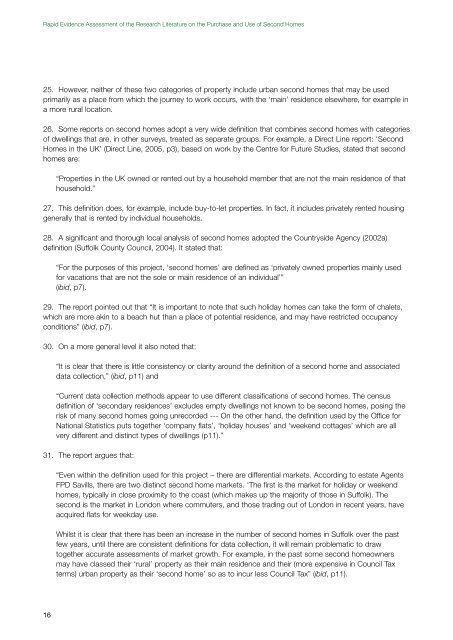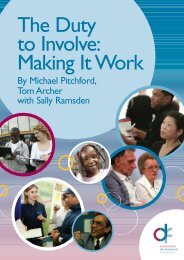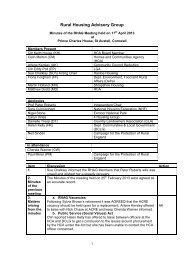Rapid Evidence Assessment of the Research ... - Rural Housing
Rapid Evidence Assessment of the Research ... - Rural Housing
Rapid Evidence Assessment of the Research ... - Rural Housing
You also want an ePaper? Increase the reach of your titles
YUMPU automatically turns print PDFs into web optimized ePapers that Google loves.
<strong>Rapid</strong> <strong>Evidence</strong> <strong>Assessment</strong> <strong>of</strong> <strong>the</strong> <strong>Research</strong> Literature on <strong>the</strong> Purchase and Use <strong>of</strong> Second Homes<br />
25. However, nei<strong>the</strong>r <strong>of</strong> <strong>the</strong>se two categories <strong>of</strong> property include urban second homes that may be used<br />
primarily as a place from which <strong>the</strong> journey to work occurs, with <strong>the</strong> ‘main’ residence elsewhere, for example in<br />
a more rural location.<br />
26. Some reports on second homes adopt a very wide definition that combines second homes with categories<br />
<strong>of</strong> dwellings that are, in o<strong>the</strong>r surveys, treated as separate groups. For example, a Direct Line report: ‘Second<br />
Homes in <strong>the</strong> UK’ (Direct Line, 2005, p3), based on work by <strong>the</strong> Centre for Future Studies, stated that second<br />
homes are:<br />
16<br />
“Properties in <strong>the</strong> UK owned or rented out by a household member that are not <strong>the</strong> main residence <strong>of</strong> that<br />
household.”<br />
27. This definition does, for example, include buy-to-let properties. In fact, it includes privately rented housing<br />
generally that is rented by individual households.<br />
28. A significant and thorough local analysis <strong>of</strong> second homes adopted <strong>the</strong> Countryside Agency (2002a)<br />
definition (Suffolk County Council, 2004). It stated that:<br />
“For <strong>the</strong> purposes <strong>of</strong> this project, ‘second homes’ are defined as ‘privately owned properties mainly used<br />
for vacations that are not <strong>the</strong> sole or main residence <strong>of</strong> an individual’”<br />
(ibid, p7).<br />
29. The report pointed out that “It is important to note that such holiday homes can take <strong>the</strong> form <strong>of</strong> chalets,<br />
which are more akin to a beach hut than a place <strong>of</strong> potential residence, and may have restricted occupancy<br />
conditions” (ibid, p7).<br />
30.<br />
31.<br />
On a more general level it also noted that:<br />
“It is clear that <strong>the</strong>re is little consistency or clarity around <strong>the</strong> definition <strong>of</strong> a second home and associated<br />
data collection,” (ibid, p11) and<br />
“Current data collection methods appear to use different classifications <strong>of</strong> second homes. The census<br />
definition <strong>of</strong> ‘secondary residences’ excludes empty dwellings not known to be second homes, posing <strong>the</strong><br />
risk <strong>of</strong> many second homes going unrecorded --- On <strong>the</strong> o<strong>the</strong>r hand, <strong>the</strong> definition used by <strong>the</strong> Office for<br />
National Statistics puts toge<strong>the</strong>r ‘company flats’, ‘holiday houses’ and ‘weekend cottages’ which are all<br />
very different and distinct types <strong>of</strong> dwellings (p11).”<br />
The report argues that:<br />
“Even within <strong>the</strong> definition used for this project – <strong>the</strong>re are differential markets. According to estate Agents<br />
FPD Savills, <strong>the</strong>re are two distinct second home markets. ‘The first is <strong>the</strong> market for holiday or weekend<br />
homes, typically in close proximity to <strong>the</strong> coast (which makes up <strong>the</strong> majority <strong>of</strong> those in Suffolk). The<br />
second is <strong>the</strong> market in London where commuters, and those trading out <strong>of</strong> London in recent years, have<br />
acquired flats for weekday use.<br />
Whilst it is clear that <strong>the</strong>re has been an increase in <strong>the</strong> number <strong>of</strong> second homes in Suffolk over <strong>the</strong> past<br />
few years, until <strong>the</strong>re are consistent definitions for data collection, it will remain problematic to draw<br />
toge<strong>the</strong>r accurate assessments <strong>of</strong> market growth. For example, in <strong>the</strong> past some second homeowners<br />
may have classed <strong>the</strong>ir ‘rural’ property as <strong>the</strong>ir main residence and <strong>the</strong>ir (more expensive in Council Tax<br />
terms) urban property as <strong>the</strong>ir ‘second home’ so as to incur less Council Tax” (ibid, p11).






